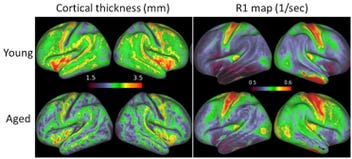The human 7 Tesla (7T) MR systems have enabled high-resolution and contrast imaging and have been applied to investigate brain pathology as well as neuroscience questions, especially in terms of high spatial resolution. The 7T/3T ratio is 2.33, and iso-SNR voxel size of isotropic 1 mm at 3T is isotropic 0.75 mm at 7T when the signal-to-noise ratio (SNR) increases linear to the magnetic field strength. However, many studies suggest supra-linear increase. The relative SNR of the whole brain at 7T compared with 3T is more than three times higher.
For T1-weighted imaging, magnetisation-prepared rapid 2 gradient echoes (MP2RAGE) are mostly used with a resolution of around 0.7 mm isotropic at 7T as compared to MPRAGE with an isotropic resolution of around 1 mm at 3T. In MP2RAGE, an image pair of 2 different inversion times are acquired, and image inhomogeneity is cancelled. In addition, fitting the longitudinal signal recovery of the two images provides a quantitative T1 map. Due to its high resolution, quantitative analysis of the cortex can be conducted. In normal aging, cortical thinning is well-known. In addition, T1 shortening is observed in aged subjects compared to younger ones (Figure 1).


Figure 1. Changes by aging in (Left) cortical thickness and (right) T1 values of healthy subjects. Cortical thinning and R1 (=1/T1) increase can be observed in aged compared with young healthy lubject.
As for the image contrast, T2*- weighted imaging (T2*WI) at 7T shows high contrast to myelin and iron. To detect subtle iron deposition, susceptibility-weighted imaging (SWI) is frequently used at 3T, however, high contrast for iron due to shortening of the T2* value may not require SWI at 7T, and T2*WI provide anatomical details and pathophysiological changes. Such high contrast of 7T is exploited in functional MRI (fMRI), where blood oxygen-level dependent (BOLD) contrast that is reflected on T2*WI.
Using its high SNR, sub-millimeter isotropic scans have recently been conducted. Laminar fMRI of the cortex is one of applications. Layer 4 of the cortex receives input mainly from the thalamus, and superficial layers mainly receive feedback from other cortical areas, whereas deeper layers mainly send information to other areas including the caudate nucleus. Investigation of layer-wise activation and/or connectivity is expected to elucidate the pathophysiology of neuropsychiatric disorders. Functional connectivity for small brain regions, such as habenula, has also been reported. Although it is a tiny structure located medial to the thalamus, the habenula is related to schizophrenia, depression, and other disorders. A network analysis of such key structures is expected to be an imaging biomarker of disorders.
Investigation of the neurochemicals may also contribute to the elucidation of pathological conditions. MR spectroscopy (MRS) can separately measure neurochemicals using their specific patterns of chemical shift peaks. The amount of chemical shift increases to the increase of the static magnetic field, enabling better separation of neurochemical peaks. The mostly measured neurochemicals at 3T were n-acetyl-aspartate, choline, creatine, myo-inositol, and lactate in addition to glutamate (Glu), which is a representative excitatory neurotransmitter, but at 7T, the inhibitory neurotransmitter, gamma- Aminobutyric Acid (GABA) can also be measured without spectral editing, although macromolecules need to be appropriately removed. Neuroprotective chemicals, such as glutathione and taurine, can also be measured. Their profiles are investigated to explore neurochemical biomarkers. In addition, dynamic changes of Glu during tasks can be observed (Figure 2), which is not very practical when spectral editing is used.

Figure 2. Changes of glutamate concentrations. An increase is observed during the finger tapping task (Tap) for 2.5 minutes compared to Rest conditions for 2.5 minutes.
It should be noted that the human 7T-MRI can also be used to investigate specimens. Mesoscopic information can be acquired using the same pulse sequences when dedicated coils are used to increase SNR. However, there exists several difficulties in 7T, such as increased inhomogeneity of both static magnetic field (B0) and radiofrequency transmit field (B1+) and increased specific absorption rate (SAR), resulting in larger signal dropout, signal inhomogeneity and lower contrast compared with 3 Tesla (3T). Aside from B0, B1+ inhomogeneity can be improved using dielectric pads or parallel RF transmission. SAR increases quadratic to the static magnetic field strength, and this is highly related to the safety. Considering these issues, 7T has already been accepted for clinical use for more than 5 years and will bring new insights into clinical practice.
References available on request.

Tomohisa Okada, MD, PhD, is the part of the Human Brain Research Center, Graduate School of Medicine at Kyoto University in Japan.


















.webp?width=700&auto=webp&quality=80&disable=upscale)